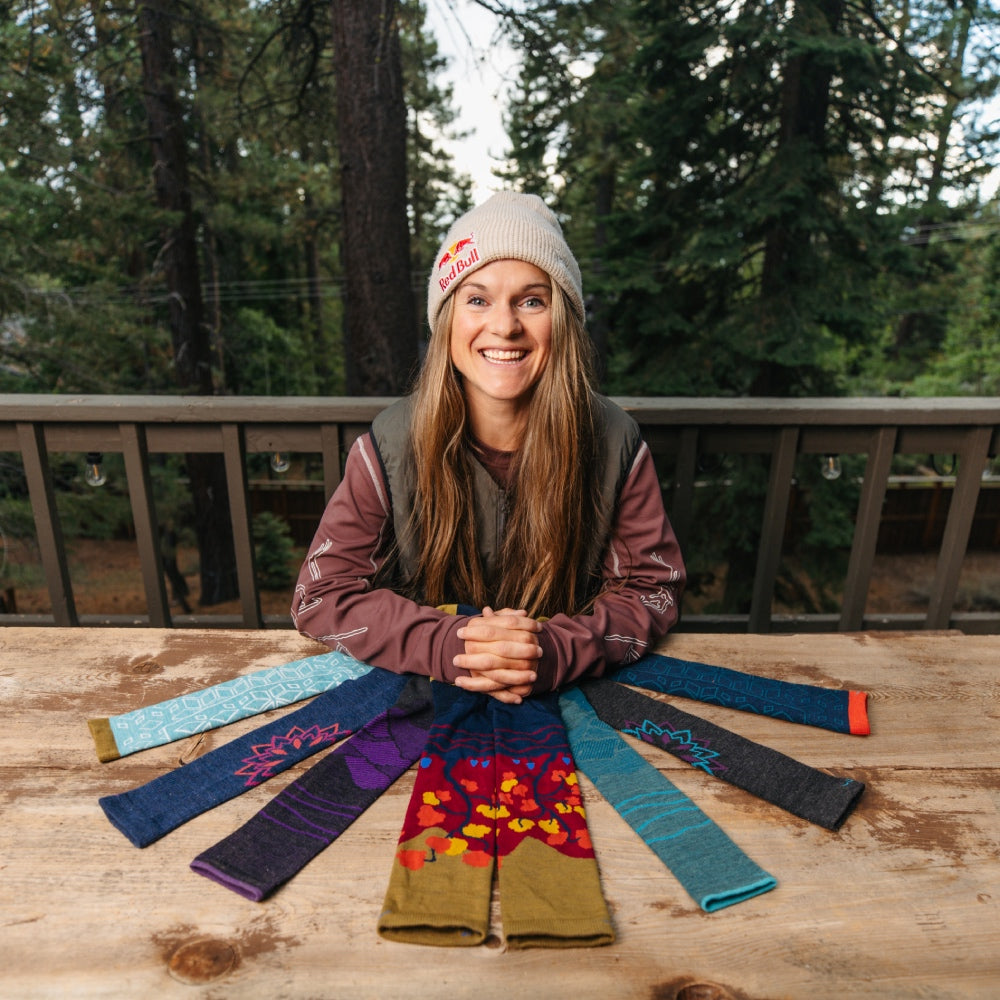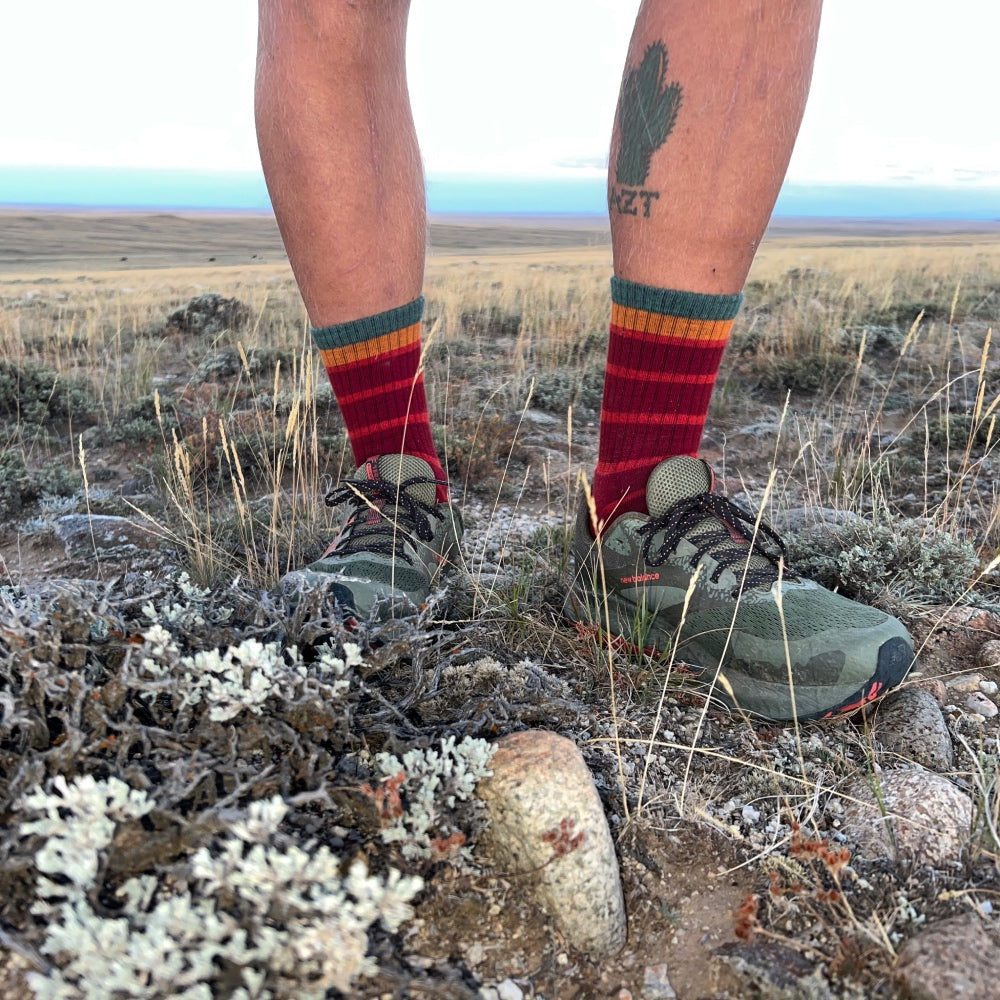Why Merino Wool Makes the Best Moisture Wicking Socks

Once Upon a Time
Long, long ago, a pair of socks was a commodity. Someone would buy an eight-pack of white cotton crew socks at a big-box store. We’d wear them every day, because that’s what you did in those days.
We also used floppy disks for storage, landlines for conversations, and CDs for playlists. Things have progressed — thank goodness — and Merino Wool socks have usurped their antiquated cotton ancestors as the go-to performance sock fabric.
Why? Many reasons, but Merino Wool’s natural ability to wick moisture and sweat is one of them.
In those old days, moisture wicking socks weren’t part of the conversation—the term didn’t get coined until the 1990s. Hikers and other athletes dealt with sweaty feet, wet socks, and the resulting blisters in whatever ways they could. Today, those in the know wear Merino Wool socks for hiking, skiing, running, and other activities where moisture management matters.
Why? Let’s get into it…
Moisture Wicking 101

What does moisture wicking mean? We hear the buzzword often today, but before we dive into why it matters and how Merino Wool wicks moisture away, let’s unpack the term.
When we do strenuous activities — known as Type II fun in some circles — we get hot. When we get hot, we sweat. Moisture-wicking fabrics will:
- Move the wetness from sweat, or the elements, away from you skin.
- Release that moisture into the air, so the fabric doesn’t become soaked.
Simple, right? Exactly what you want in a base layer. The purpose of moisture and sweat wicking socks is to keep your feet dry by controlling the moisture around your feet, whether that moisture is from sweat or from an accidental dunk crossing a stream.
Do Dry Feet Matter?
Yes, they do. And not just because we find the whole wet-sock-squishing-in-shoe scenario gross. No one likes the word moist, but moist feet and wet socks that keep them that way are a recipe for disaster.

First off, wet socks make your feet more vulnerable to blisters. Blisters come from friction, and moisture can increase the friction between your foot and sock, increasing the risk of blisters and sores. Prolonged exposure to moisture also softens your skin, weakening it and making it more likely to… you got it, blister.
But blisters aren’t the only reason dry socks matter. Damp, wet feet are exactly the environment odor-causing bacteria and fungus love to live in. Wearing moisture wicking socks is an investment in your foot health, helping to prevent stinky shoes and conditions like athlete’s foot.
Lastly, if you’re being active in cold weather, you already know that cold and wet are a dangerous combination. Wet socks on a hot day might cause blisters, but those same socks on a chilly winter day can lead to frostbite, as most fibers lose their ability to insulate when wet (more on that to come).

To sum up, dry feet are healthy feet; moisture wicking, quick-drying socks play a vital role in keeping your feet dry. Which leads to the final question: what moisture wicking socks are best?
Merino Wool Socks: Naturally Moisture Wicking
It’s no secret… we love Merino Wool. We think this natural fiber makes the best socks, whether they’re stuffed into a work boot or worn on the Appalachian Trail. This performance fiber has many natural benefits, including thermoregulation, durability, breathability, and softness. And though other moisture wicking materials exist, we’ve found the best socks for wicking moisture are made with Merino.
Synthetics
Most moisture wicking fabrics are synthetics. Our vegan-friendly Coolmax sock styles are examples of moisture wicking synthetic socks. These synthetics are hydrophobic, meaning they resist water, helping the fabric itself stay dry.

To dry your feet, these materials are designed with tiny spaces or channels that actively transport moisture from the surface of your skin to the outside of the sock, where it can evaporate away.
Coolmax, Thermolite, and other synthetic materials do an admirable job, but as is often the case, nature did it better.
Sheep Wick, You Can Too
Merino is one of nature’s most functional materials. Nature knows best.
Picture the headlands of New Zealand, sprinkled with sheep. Winds whip off the coast and rain pelts down from above, but the sheep are comfy and content. These Kiwi sheep are straight up covered in Merino Wool. Like those high-country sheep, your feet can weather whatever weather is thrown your way.

The structure of Merino Wool fibers is designed to keep you — and the sheep the wool came from — dry and cozy when it’s dreary and damp. Wool boasts otherworldly abilities to trap air between its fibers, and the structure of these fibers keep the wearers warm. Yet, wool also regulates heat to keep you cool, and manages moisture to keep you dry. How is that all possible?
The abridged answer is: As your feet heat up, socks made with Merino Wool will absorb the moisture before it turns into sweat on your skin. Like synthetics, Merino has tiny channels that move the moisture away from your foot to the outside of the sock, where it can evaporate. Unlike synthetics, the interior and exterior of Merino fibers have different reactions to water.
The outside (cuticle) of Merino fiber is hydrophobic – it’s moving that water onward, away from itself. The inside of the fiber (core) is hydrophilic. That porous inner core will absorb some of the moisture vapor, holding onto it, while still leaving the outer layer of the fiber that sits against your skin dry to the touch. And the fibers are good at this, so good that a fiber can absorb up to 35% of its own weight in water before feeling wet to the touch, even in high humidity.

Why is absorbing some of the moisture into the core an advantage over synthetic fabrics, that instead move the water right out? That’s where Merino’s moisture wicking properties overlap with its unmatched ability to keep your feet the right temperature.
Remember, wool keeps you cool in hot weather (and is therefore great for summer). That’s because Merino fibers don’t just wick away moisture – they first put it to good use. By selectively holding on to some of that moisture in the fiber’s core, away from your skin, the socks still feel dry to you, but now have the ability to release that moisture at the right moment.

When your foot starts to get too warm, the fibers release the moisture. And voila, your feet cool down via evaporative cooling. As a result, your feet stay dry and cool.
Mother nature. She knows her stuff.
Not Cotton
For the best moisture wicking socks that also regulate your foot temperature, we recommend Merino Wool socks. If you’re looking for a synthetic or vegan alternative, our Coolmax styles (like these running socks) will get the moisture control job done.
The one common sock material you should avoid: cotton. Cotton socks acts like a sponge, holding onto water and drying slowly, which is not the vibe we want when we sweat.
Beyond the Socks
Socks are your first line of your defense against moisture, but they’re not the last. Pairing moisture wicking Merino Wool socks with breathable footwear leads to top-notch performance.

At Darn Tough, we’ve got a lot of hours into studying this, and we’ve fine-tuned our sock designs by activity for the best foot-sock-shoe performance, including when it comes to managing moisture. Part of that includes adding vents or mesh panels when we know these socks are going to be in traditionally less breathable footwear to help channel that moisture up and out.
When Your Socks Get Wet
You might ask, does wearing moisture wicking socks mean they never feel wet? No – enough moisture, and any material will start to feel damp. If you jump feet-first, socks-on into a stream, even Merino Wool socks will be squishing when you step out onto the rocks.

Remember, Merino can hold over 30% of its own weight in water before beginning to feel wet, keeping clammy feet at bay longer than other materials. But when Merino Wool does get well and truly wet, that’s when it really shines. Unlike other sock materials, wet Merino:
- Keeps Insulating. Most fabrics lose their ability to insulate when wet, meaning they’re no longer keeping you warm on cold days. Merino isn’t most fabrics though – even when soaked, Merino Wool socks continue to insulate, keeping your toes warm when they need it most.
- Maintains Its Shape. Wet socks are saggy socks, literally falling down on the job. But not if they’re Merino socks. Merino has an amazing ability to maintain its shape when wet, so you don’t lose that performance fit.
- Fights Odor. Three days of hiking through nonstop rain… maybe you know that smell. Merino clothing fights odor and bacteria build up, helping keep those foot odors to a minimum all day long.
And whenever the sun does come back out, our Merino Wool socks are quick drying, managing that moisture quickly and efficiently.

Is Merino the fastest drying sock material out there? No. There are synthetic options that dry faster. There’s a fair chance they’ll feel wet faster and stink sooner, too, lacking Merino's strong odor resistance.
Merino’s a choice; we think it’s the right one. Worth noting that our socks are knit using Merino Wool, Nylon, and Lycra, so they’ll dry faster than 100% wool socks.
Socks That Wick Moisture in the Wild
You can rock the Animal Haus in summer with sandals at the farmer’s market or slide into a pair before a day on your feet traveling in a new city. Either way, your dry feet will appreciate the Merino Wool that wicks moisture away with ease.

A day spent thru hiking and passing mile markers on Vermont's Long Trail in our Treeline Micro Crew means your night in the tent will smell a bit better and your feet will be drier than if you chose to pound distance and vert in socks sans Merino Wool. Even in wet trail conditions.

Rubber boots aren’t known for their breathability, so we developed the Stanley K and Emma Claire work socks. Mesh windows on the foot and up the leg help everything breathe, releasing moisture and warm air out and over the top of the boot, even after hours on deck. The result? Super breathable boot socks.
Moisture Wicking Class Dismissed
Everything we do has a purpose. We choose Merino Wool for our socks because it’s wildly resilient and incredibly versatile. It’s the world’s most versatile performance fiber, and its ability to wick away moisture will keep your little piggies dry and comfy until long after the cows come home.







